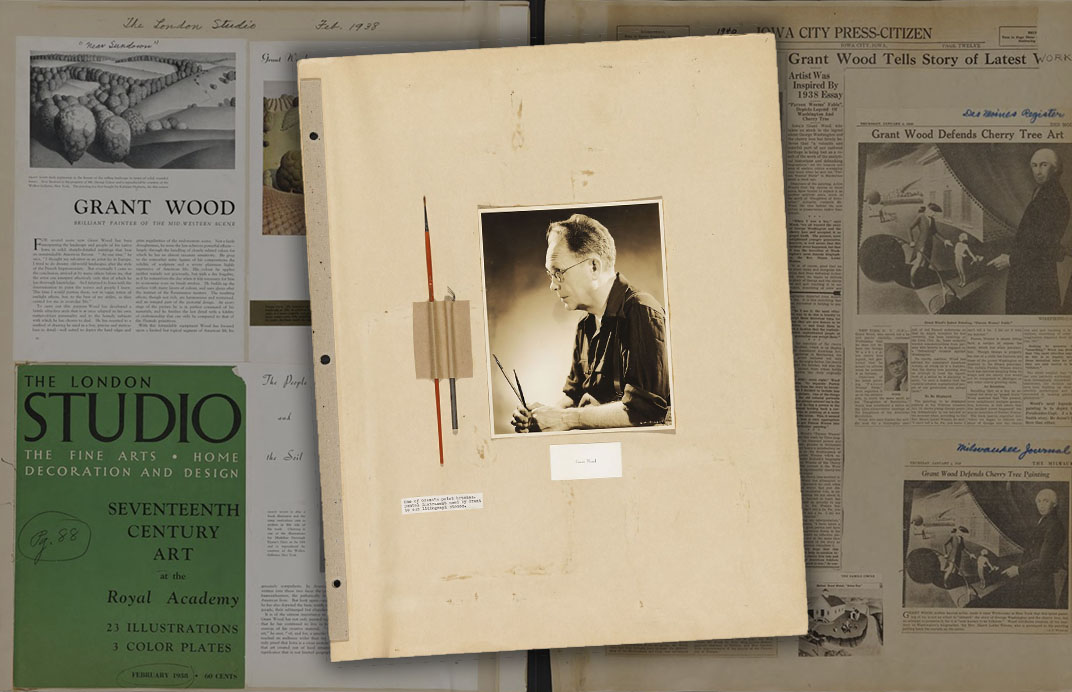Iowa Art Experts Set Out to Catalogue Grant Wood's Prolific Career
 PHOTO: FIGGE ART MUSEUM GRANT WOOD DIGITAL COLLECTION/IOWA DIGITAL LIBRARY
The cover of a scrapbook compiled by Nan Wood Graham, Grant Wood's sister, includes a portrait of the artist and his tools of the trade.
PHOTO: FIGGE ART MUSEUM GRANT WOOD DIGITAL COLLECTION/IOWA DIGITAL LIBRARY
The cover of a scrapbook compiled by Nan Wood Graham, Grant Wood's sister, includes a portrait of the artist and his tools of the trade.
No artist captured the essence of Iowa quite like Grant Wood, whose bucolic landscapes and portraits of salt-of-the-earth Midwesterners earned him the nickname “America’s painter of the soil.” Yet Wood’s artistic range extended far beyond regionalist works such as American Gothic, the painting that catapulted him to fame nearly a century ago.
In his early years, Wood experimented with impressionism after traveling to Europe, and for a time he operated a jewelry and fine metalwork shop in Chicago. The former University of Iowa professor also crafted furniture, sculptures, and stained glass, and he was deeply interested in architecture and interior design.
Wood was so prolific, in fact, that the full scope of his work remains unclear to scholars. To address this, a new UI research project aims to illuminate the breadth of Iowa’s most famous artist by building a comprehensive database of Wood’s works, helping fortify his legacy.
The three-year endeavor will create a digital scholarship tool—known in the art world as a catalogue raisonné—that will detail Wood’s paintings, prints, drawings, murals, and decorative work in metal and wood, as well as his public and private commissions. The project will also establish a multidisciplinary arts and humanities initiative at Iowa dedicated to studying Wood’s life and work.
“If we’re really trying to elevate Grant Wood to his well-earned spot in art history, then we need to have this kind of resource available for scholars and the next generation of students,” says Maura Pilcher, director of the UI-based Grant Wood Art Colony. “A lot of the texts not only overlook Grant Wood, but regionalism in general, and that’s a huge part of our cultural legacy as Midwesterners—and for the United States. It was a truly American style at a time when a lot of people were looking to Europe and other locations for inspiration.”
Wood, who grew up in Anamosa and Cedar Rapids, taught at Iowa from 1934 to 1941 in his studio at the original Art Building. He died from cancer at age 50 in 1942 at University Hospital in Iowa City. Even today, collectors, auction houses, and people who have inherited pieces come forward with artwork believed to be created by Wood, but there is no resource to collect and catalogue this information.
The Grant Wood Art Colony, in partnership with UI Libraries and the UI Stanley Museum of Art, secured a grant for $296,743 from the Carver Charitable Trust to fund three years of the catalogue raisonné project. Further grants and private fundraising will support the full scope of the endeavor. This past fall, the art colony hired alumna Ranelle Knight-Lueth (06MA, 15PhD) as project manager to lead the development of the catalogue.
The project team will include a graduate research assistant, undergraduate interns, and an advisory panel of scholars and legal experts. Researchers will partner with museums and sift through records and published materials in search of forgotten works, track provenance details of known pieces, and ultimately create a database of Wood’s output.
The web-based resource will also serve as a repository for scholarship and creative works related to Wood and the regionalism movement he championed. It will be freely available to scholars, museums, art dealers, and the public.
Says Pilcher: “Wood was never an elitist, so we want an accessible database where everybody can dig in.”

